

Sitiocinemanostalgia. Por Víctor Manuel Hernández Con inicios a partir del movimiento artístico y literario lidereado por André Breton en 1919, los antecedentes del CINE SURREALISTA surgen a mediados de los años 20’s con distintos experimentos vanguardistas realizados en París, como los cortometrajes “Le retour à la raison” (“El regreso a la razón”, 1923), “Emak-Bakia” (1926), “L´étoile de la mer” (“La estrella del mar”, 1928) y “Les mystères du château de Dé” (“Los misterios del Castillo de Dé”, 1929) del fotógrafo Man Ray:“Entr´acte”(Entreacto, 1924), del futuro cineasta René Clair; “Ballet mécanique” (“Ballet mecánico”,1924), del pintor cubista Fernand Léger y del artista visual Dudley Murphy; “Anémic Cinéma” (“Cine anímico”, 1926), del artista multidisciplinario Marcel Duchamp o “La souriante Madame Beudet” (“La sonriente Señora Beudet”).

La que es considerada la gran obra maestra del cine surrealista fue realizada con un prespuesto de 25 mil pesetas que aportó la madre de Luis Buñuel. How Recent Films Have Utilized Older or Non-Standard Aspect Ratios to Their Advantage. You may be familiar with the standard aspect ratios typically found on the web or in theaters, but filmmakers have a long history of experimenting with their frames.
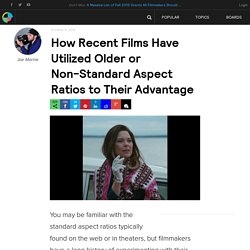
We wrote previously about Xavier Dolan utilizing a square 1:1 aspect ratio for Mommy, but a number of other examples are explored in this terrific video from De Filmkrant: Aspect ratios have a long strange history as far as filmmaking is concerned, something that photography, another visual medium, hasn't had as much trouble with. While you may find some of these examples distracting in the context of watching the actual films, the one thing they all share in common is an attempt to expand beyond the confines of arbitrary standards to better suit the narrative. Camera basics - What does f-stop mean? - Photography Stack Exchange. "The Easy Guide To Understanding Aperture (f Stop)" by Peter Hill. Introduction Have you ever asked yourself a question similar to one of these?

What’s with all the f/2.8 and f/1.4 and f/22 stuff people use in their Descriptions? Photography and Math. Photography and Math Copyright 2004, 2010, Mark D.
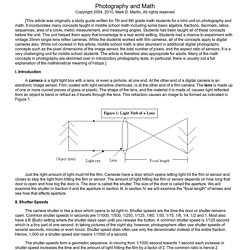
Martin, All rights reserved [This article was originally a study guide written for 7th and 8th grade math students for a mini unit on photography and math. It incorporates many concepts taught in middle school math including some basic algebra, fractions, decimals, ratios, sequences, area of a circle, metric measurement, and measuring angles. Students had been taught all of these concepts before the unit. This unit helped them apply that knowledge to a real world setting. I. A camera is a light tight box with a lens, or even a pinhole, at one end.
A Tedious Explanation of the f/stop. By Matthew Cole Photographers set their exposure using a combination of shutter speeds and f/stops to get the correct amount of light on the sensor (or film).

The shutter speed regulates how long the sensor is exposed to light coming through the lens. The f/stop regulates how much light is allowed through the lens by varying the size of the hole the light comes through. For any given film speed (ISO) and lighting combination there is one correct amount of light to properly expose the image. Estetica Del Cine. Gaudreault y Jost - El Relato Cinematográfico. El arte cinematográfico - Bordwell y Thompson. You're reading a free preview.
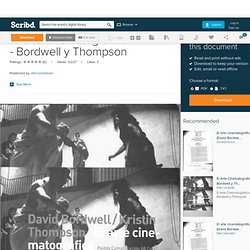
Pages 11 to 28 are not shown in this preview. You're reading a free preview. Observations on film art. The Adventures of Prince Achmed.
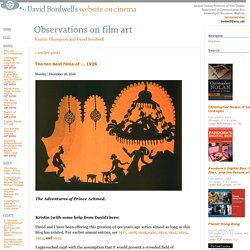
Kristin (with some help from David) here: David and I have been offering this greatest-of-90-years-ago series almost as long as this blog has existed. For earlier annual entries, see 1917, 1918, 1919, 1920, 1921, 1922, 1923, 1924, and 1925. Vljs0v5fx. André Bazin. Digital Filmmaking, Digital Filmmaking Courses, Digital Filmmaking School.
List of motion picture terminology. Tech. Auteur theory. In film criticism, auteur theory holds that a director's film reflects the director's personal creative vision, as if they were the primary "auteur" (the French word for "author").

In spite of—and sometimes even because of—the production of the film as part of an industrial process, the auteur's creative voice is distinct enough to shine through studio interference and the collective process. Film Education. Ella Shohat Multiculturalismo y Cine. Mexican cinema: reflections of a ... - Carl J. Mora. Lo verosímil como efecto del corpus. Como hacer una película. Third World film making and the West - Roy Armes.
Cinema of Mexico. The history of Mexican cinema goes back to the ending of the 19th century and the beginning of the 20th, when several enthusiasts of the new medium documented historical events – most particularly the Mexican Revolution – and produced some movies that have only recently been rediscovered.
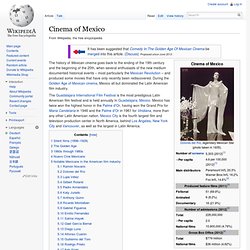
During the Golden Age of Mexican cinema, Mexico all but dominated the Latin American film industry. The Guadalajara International Film Festival is the most prestigious Latin American film festival and is held annually In Guadalajara, Mexico. Mexico has twice won the highest honor in the Palme d'Or, having won the Grand Prix for Maria Candelaria in 1946 and the Palme d'Or in 1961 for Viridiana, more than any other Latin American nation. Mexico City is the fourth largest film and television production center in North America, behind Los Angeles, New York City and Vancouver, as well as the largest in Latin America. Silent films (1896–1929)[edit] Teshome Gabriel. Teshome H.
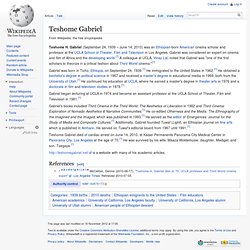
Gabriel (September 24, 1939 – June 14, 2010) was an Ethiopian-born American cinema scholar and professor at the UCLA School of Theater, Film and Television in Los Angeles. Teoría cinematográfica. Miradas - Mientras más verosímil y no verdadero sea el cine, mejor 1- Creo que lo “latinoamericano” está incluido en cualquier película latinoamericana que sea honesta y que funcione. Creo que los latinoamericanos nos identificamos por asuntos históricos, políticos y sociales nutridos por nuestras tradiciones, que además funcionan y se entienden en la vida moderna. Me declaro enemigo del uso gratuito del folklore para dejar claro de dónde viene una historia, para conmover y vender sin sentido narrativo.